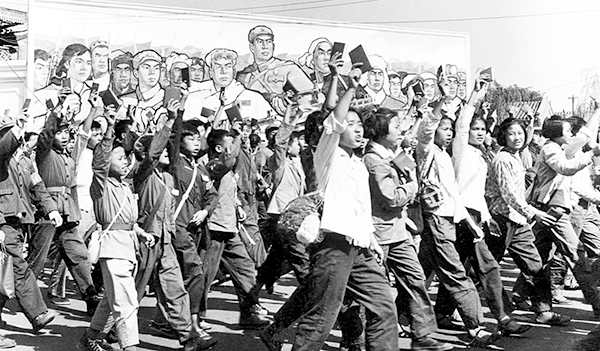Bitter legacy of the Cultural Revolution

On Jan. 12, about 20 seniors returned to the middle school attached to Beijing Normal University. They visited the statue of Bian Zhongyun, the deputy principal of the school in the 1960s. They offered a silent tribute to her, and some cried. One of them was Song.
In the summer of 1966, the school was full of revolutionary spirit. The Cultural Revolution was inspired by Mao Zedong’s anti-rightist political struggle to “strike the command,” and the Chinese society was in a vortex of revolution. Song, the daughter of a high-ranking official, was an executive of the Red Guards. It was during the time when students criticized principals and sons condemned their own fathers. Bian was beaten by the Red Guards and died on Aug. 5.
Ten days later, Song met Mao Zedong at Tiananmen Square for the celebration of one million Red Guards for the Cultural Revolution. She famously put a Red Guard pin on Mao. Then, Mao gave Song the nickname “Yaowu,” meaning “Be militant.” Song became a synonym for the militant Red Guard.
After the Cultural Revolution, she came to the United States to study, an opportunity that was available only to the children of revolutionary executives. Upon receiving a Ph.D. from MIT, she stayed in the United States. When she returned to her alma mater on Jan. 12, she cried before the statue of the teacher she had killed.
As her apology inspired debate over her sincerity, it started a discussion on the once-taboo topic of the Cultural Revolution. Before and after her apology, many people came to confess their sins and seek forgiveness. Some intellectuals say that the state and the Communist Party also need to speak up. They demand that the authorities explain what persuaded the 19-year-old girl to go on a “killing spree.” The issue has been brought up before the Chinese People’s Political Consultative Conference.
The Cultural Revolution is a living part of history. Any Chinese over the age of 60 lives with painful memories of being assailants or victims. The revolution tore the society apart and destroyed the economy in the 1960s, and the wounds haven’t healed yet. The Communist Party defines the Cultural Revolution as “a serious mistake,” but it hasn’t addressed what went wrong and how. It may be waiting for the tragedy to be forgotten. The intellectuals helplessly claim that China could experience a similar tragedy unless it cleans up its past. It may be the limit of the Chinese society.
The author is director of the China Institute of the JoongAng Ilbo.
JoongAng Ilbo, Mar. 3, Page 30
By HAN WOO-DUK
매년 봄 열리는 중국 양회(정협, 전인대)가 올해도 어김없이 오늘 시작된다. 다양한 직군의 대표들이 참가해 의견을 개진하는 정치자문기구 정협은 중국 사회 흐름을 읽는 데 유용하다. 정협 기사를 검색하던 중 '송빈빈(宋彬彬)'이라는 인물과 만나게 된다. 문화대혁명(문혁)과 관련된 그의 얘기를 엮자면 이렇다. 지난 1월 12일. 머리가 희끗희끗한 노인 20여 명이 베이징사범대 부속중학교(사대부중)를 찾았다. 그들이 향한 곳은 1960년대 중반 이 학교 부교장을 지낸 볜중윈(卞仲耘)의 동상(銅像). 그들은 동상에 묵념했고, 일부는 눈물을 흘리기도했다. 그 중 한 명이 바로 송빈빈이었다. 송빈빈-볜중윈의 악연은 48년 전으로 돌아간다. 1966년 여름, 사대부중은 혁명의 열기로 가득찼다. '사령부를 폭격하라'는 마오쩌둥의 반(反)우파 정치 투쟁으로 시작된 문혁은 학생들을 혁명의 소용돌이로 몰아넣었다. 고위직 딸이었던 송빈빈은 홍위병 간부 완장을 찼다. 학생이 교장을 비판하고, 심지어 아들이 아버지의 뺨을 때리는 시절이었다. 홍위병들은 볜 부교장을 끌어내 이리저리 끌고다니며 구타했고, 결국 8월 5일 죽음에 이르게 했다. 송빈빈은 10일 후 천안문 광장에서 열린 '문혁 축하 백만인 대회'에 참가해 마오쩌둥과 만나게 된다. 단상에서 마오에게 홍위병 완장을 달아준 학생이 바로 그였다. 당시 마오는 송빈빈에게 '송야오우(宋要武)'라는 별명을 붙여줬다. '무장할 필요가 있다'는 뜻, 송빈빈은 그때부터 '무장 홍위병'의 대명사로 불렸다. 문혁이 끝난 뒤 그는 혁명 간부의 자식이 아니라면 꿈도 꾸기 힘들 미국 유학 길에 올랐고, MIT에서 박사학위를 받은 뒤 아직까지 현지에서 살고 있다. 그런 그가 1월 12일 모교 사대부중을 찾아 볜윈중의 동상 앞에서 참회의 눈물을 흘리게 된 것이다. 그의 사과를 놓고 '진실 논쟁'이 벌어졌지만, 금기시됐던 '문혁'이라는 화두를 중국 사회에 던지기에는 충분했다. 그 사죄를 앞뒤로 많은 이들이 언론을 통해 자신의 '죄악'을 스스로 토로하고, 용서를 구하고 있다. 일부 지식인들은 이제 국가와 당(공산당)이 나서야 할 때라고 말한다. 무엇이 19살의 어린 소녀를 '살인 대열'에 서게 했는지, 진상을 요구하고 있는 것이다. 정협을 앞두고 이 문제가 제기되는 이유다. 문혁은 살아있는 역사다. 60세를 넘긴 중국인이라면 누구나 가해자, 또는 피해자의 쓰라린 고통을 안고 살아간다. 1960년대 사회를 갈기갈기 찢고, 경제를 파탄으로 몰고갔던 문혁의 상처는 아직도 아물지 않고 있다. 공산당은 문혁에 대해 '대단히 잘못된 일'이라고 규정하면서도 무엇이, 어떤 과정으로 인해 잘못된 것인지에 대해서는 말이 없다. 그들은 잊혀지기 만을 기다리고 있는지도 모른다. '문혁을 청산하지 않으면 문혁과 같은 또 다른 동란이 일어날 수 있다'는 지식인들의 외침은 공허하다. 중국 사회의 한계다. 한우덕 중국연구소 소장










with the Korea JoongAng Daily
To write comments, please log in to one of the accounts.
Standards Board Policy (0/250자)